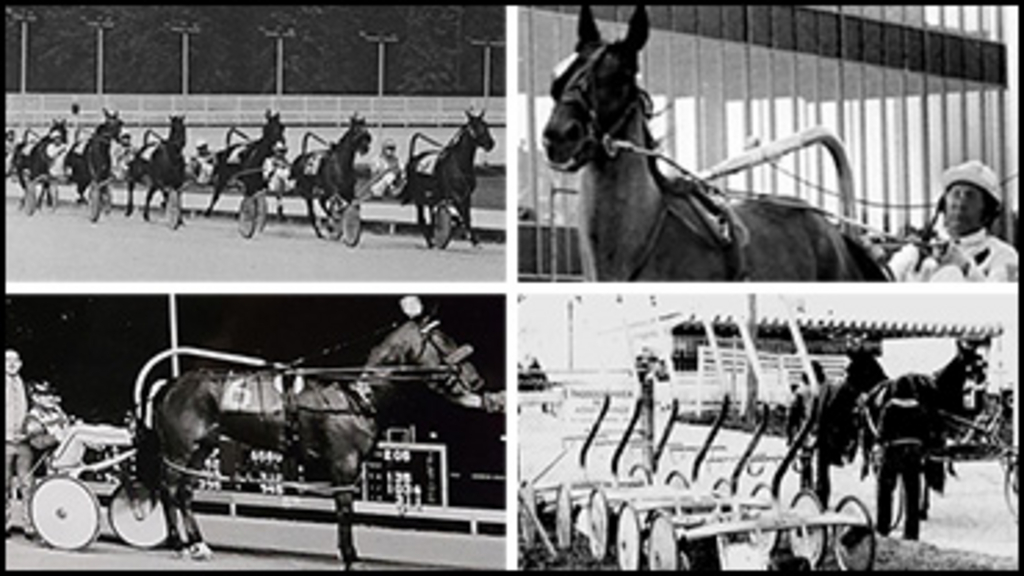
In this week's edition of 'Rewind,' Robert Smith takes readers back in time to 1970 and a few years that followed. At that time harness racing was experimenting with a very new vital piece of equipment which was at the very base of the sport. The sulky and its basic design had not undergone such drastic changes since the late 1800's. A few happenings, stories and photographs help to capture the times and the eventual outcome.
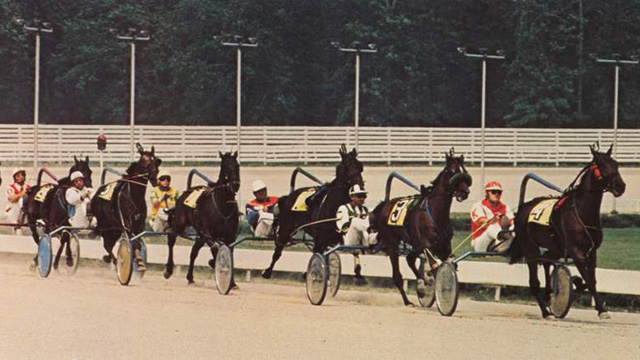
A full field of horses all using the single shaft sulky in action at Windsor Raceway in 1973 (Windsor Star)
Back in 1970 harness racing was beginning to embrace its latest and undoubtedly largest change of the 20th century. A new-fangled device most often referred to as a "contraption" was rapidly gaining in acceptance and popularity all across the sport. The single-shaft sulky was apparently here to stay. Several so-called experts long involved with harness racing predicted that the new piece of equipment would soon replace the conventional double-shafted bike sulky that dated back to 1894. One such person was Leon Greenberg, President of Monticello Raceway, who envisioned it being in universal use within five years of its introduction.
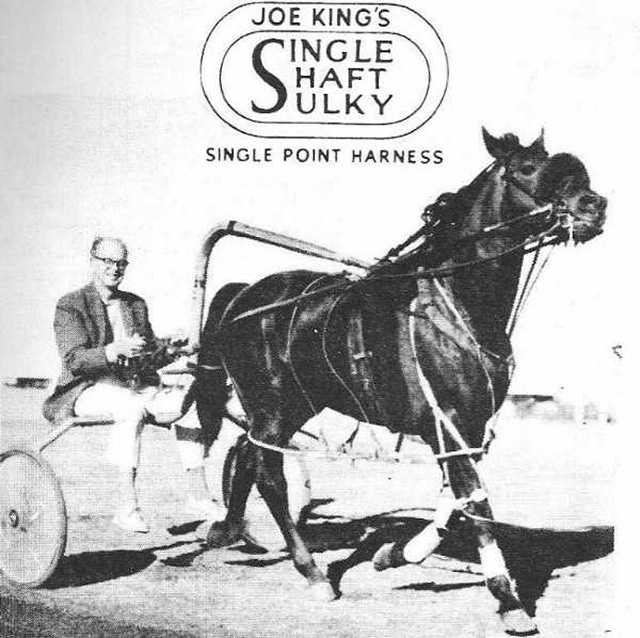
Joe King shows off his new style sulky
For several years and in fact perhaps decades, a man named Joe King had been dabbling and experimenting with his new and what he believed was an improved sulky. An army aeronautical engineer, he had combined the skills of his profession and his practical knowledge from his military experience to come up with his new and very different design. King had also trained and owned a few horses, so had first-hand experience. Down through the years many attempts to improve the existing sulky had been tried and a number put into effect but most were subtle refinements; his was a major leap. After many trials and re-dos, he finally convinced enough people in the industry to try his new invention.
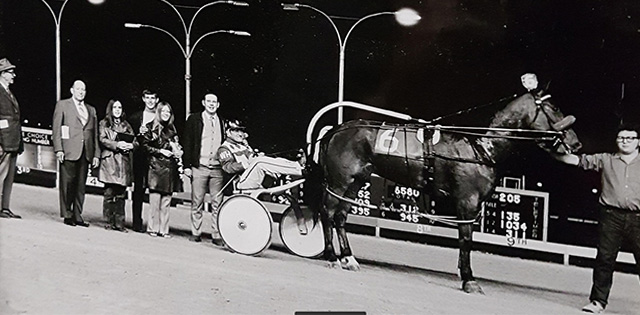
Meadowview Ben appears in the Garden City winner's circle following his win using the brand new single shaft sulky. On hand to greet driver Bill Hicks and owner Charles Reid were C.T.A. President Allan Dickenson (second from left) and sulky designer Joe King on the far left.
The following is an excerpt from the July 1970 issue of Harness Horse Happenings penned by Wm. Galvin:
On June 20, 1970 before a crowd of 5,151 inquisitive fans, the new sulky made its world debut at Garden City Raceway in St. Catharines, Ont. The mod 40 lb. stainless steel sulky was hitched to a five-year-old pacer named MEADOWVIEW BEN, owned by Charles Reid of Orono. Bill Hicks of Greenwood was in the sulky for the 2:05 mile which was the horse's fastest ever to that point.
"It was a comfortable drive" according to Hicks, who admitted Meadowview Ben had never beaten that calibre of horses before. The new sulky had an arched shaft directly over the horse's back which was connected to the back pad of the modified harness. A small cross bar on the shaft provided a foot support or stirrup.
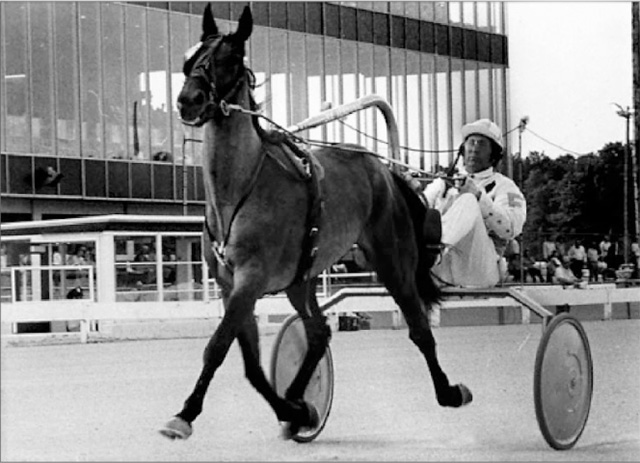
Michigan driver Bud Foster is shown using a single shaft sulky at Windsor Raceway in 1973.
Over the next few years the new sulky made its way into numerous jurisdictions in both Canada and the U.S. It did appear to allow a horse to immediately improve on previous race times which certainly appealed to a number of trainers, drivers and owners. In the all-important wagering community (remember the bettors fund the whole system) astute punters began to wager on "sulkies" rather than horses. Thus an entirely new dimension was added to the sport. In a fairly short time more and more people either purchased or rented the new era sulkies.
Throughout its relatively short existence the new sulky was never fully embraced nor accepted. The major raceways of the day -- Roosevelt and Yonkers -- shunned the new invention citing safety concerns. In a word they just were not interested in its introduction to their racing programs. Billy Haughton, the top horseman of the time, acknowledged it (and may have used it) but expressed caution as the wave of the future. Many experimented with it while others were not at all convinced and disregarded its usefulness. At least one track in Michigan allowed the sulky for training miles but not for use in actual races.
In early July of 1973 the new sulky experienced its finest hour in front of a crowd of 5,984 inquisitive fans. Windsor race secretary Joe DeFrank set up a race where the entire field used the new sulky. This was believed to be the first time it had ever happened. The winner of the race was a horse named Tension owned by Jerry Langlois of nearby Oldcastle and driven by George Hewitt. The winner, a seven-year-old pacer, clipped two seconds off his lifetime best winning in 2:03.4.
"How can you knock it when you win?" cracked Hewitt following the win. "I'm impressed with the sulky and I'm going to give it a try," he added. Another happy man on hand that day was Joe King, the sulky's inventor. In addition to seeing a full field of horses using his creation he also had his own horse Vantage Hanover entered in the tenth race. To add a storybook ending to the day, Bev Kingston piloted King's horse to victory. After being parked for a half mile he surged to the lead winning in 2:03 flat.
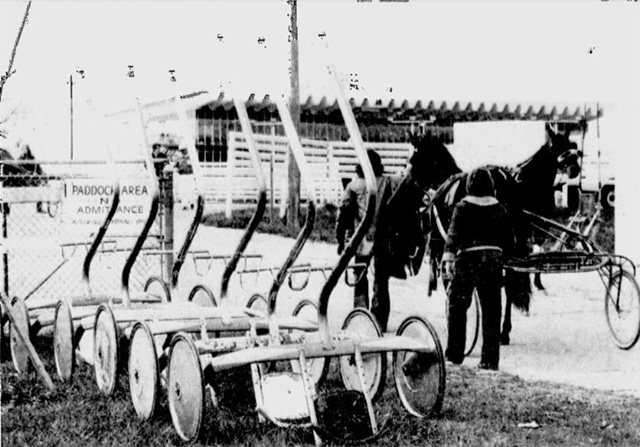
A row of single shaft sulkies sit idle on the backstretch just outside the paddock at Windsor Raceway as different factions attempted to work out a solution to the controversial new piece of equipment in the fall of 1973 (Windsor Star)
In the fall of 1973 the use of the single-shaft sulky became a major issue at the opening of the fall meeting at Windsor Raceway. While the track enjoyed its finest opening ever, those behind the scenes had deeper concerns. The majority of competitors boycotted the entry box, refusing to race if a non-traditional sulky was entered. This back and forth eventually resulted in a short strike which closed down the Raceway. After a five-day hiatus, a temporary settlement was reached and racing resumed. Stake races were open to the single shaft by prior agreement and entries were shown as (SS).
Finally a consensus was reached by the C.T.A. and a public announcement was made in late 1973 which essentially ended the use of the new style sulky.
In issuing the statement Gordon Pepper, Publicity Director of the C.T.A., stated the following message. "Only the conventional dual-shaft sulky and dual hitch variety described as any sulky having two shafts attached to both sides of the horse, the horizontal level of which shall never be greater than the height of the horse's withers shall be in use."
What then to do with a still useful sulky that can no longer be used in races? In a recent conversation with former horseman and long-time racing judge Paul Harrison, he had the perfect answer. He sent one of the last he had used to one of his inventive owners who converted into a rather unique roadside mail box.
In a short time the memory of the new and revolutionary single-shaft sulky faded into history; lost virtually forever.
Who Is It?

How many drivers can you identify from the picture appearing at the top of the page? The first three are all that I am sure about. The correct answers will be given during the coming week.


The horses and drivers shown
The horses and drivers shown in this week's picture are Ross Hutch (Bev Kingston) followed by Shiaway Adios (Pat Crowe), next is Glenvaldo Brook (Gerald Aiken). Trailing the first three were more difficult to identify but I believe were Tension (Geo. Hewitt), Studly (Bud Foster) and Governor Byrd (Ward Dey).
The Windsor photo of the single shaft sulky field showed the following results .Some of these horses did not appear in the featured picture. 1st: Tension (Geo. Hewitt), 2nd: Glenvaldo Brook (G. Aiken), 3rd: Ross Hutch (Kingston), 4th: Shiaway Adios (Pat Crowe), 5th: Governor Byrd (Ward Dey), 6th: Highland Carrie (Greg Wright), 7th: Studly (Bud Foster), 8th: Jackie Grattan (Shelly Goudreau).
Thanks for your thoughtful comments which greatly add to the story.
Working for Chris
Working for Chris Christoforou in the early-mid 70's, I recall sitting in the single shaft sulky, feeling like you were going to fall out the side. Your stirrups were either side of the shaft. Couldn't put a gating strap on to keep the horse straight. Only a few of those bikes were on the grounds of the OJC at the time. I remember the cotter pin falling out on one of Gary Crowe's horses (Reyag Gerald I believe) as they were coming over the bridge at Garden City to warm up, and the horse getting loose when the bike flipped over.
3 problems with the single
3 problems with the single shaft.
1. I saw Ace Of Aces turn right around and look at Chris Storms one day in Kingston. 2. There was no support for the outside of the wheel 3. Drivers had trouble attaching a mud sheet. My GREAT friend Mr. Charles Reid never looked better!
I own a single shaft sulky
I own a single shaft sulky which may someday hold my mail box. When I was driving horses in that bike it felt like their feet barely touched the ground. To me the horse felt freedom as he was being lifted by the shaft. The safety factor was that you were driving as if it was a truck and trailer and not a straight load. For the horse the concept has been unmatched to this day.
The drivers in the picture: Bev Kingston, Pat Crowe, Gerald Aiken, George Hewitt, Bud Foster.
Great article Robert, you bring back so many memories every week. Thank you.
The three Jack named plus
The three Jack named plus George Hewitt and Bud Foster.
George Hewitt was the first
George Hewitt was the first driver to fully embrace the SSS, and for his reward, as the sceptics were making up their minds, George won the driving championship at Windsor. The bike improved just about every horse, by 2 seconds. With the single point hitch, most horses looked like they were running free. The downside came when a horse broke stride or tried to turn unexpectedly - it was that safety issue that killed the bike.
Ford Henwood, from Michigan, bought a fleet of the $1,200 bikes and rented them out of the paddock, for $25 per race.
The next bike that came along was a another single point hitch, with 2 shafts along the side, with straps, technically meeting the new standards. Just wasn't the same.
As for George Hewitt, who loved the limelight - he hosted the Windsor Raceway tv show and "Open Roads" tv show on local Channel 9, he came up with the idea of his name on the back of his colours, like all the major sports players. Ultimately, he was forced to remove his name, or be penalized.
And now, you know the rest of the story.
Bev Kingston Pat Crowe Gerald
Bev Kingston Pat Crowe Gerald Aiken